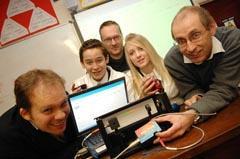In January science teachers and students at Parkview Community School, Chester-le-Street were the first to unpack Spectroscopy in a Suitcase. What did they find?
The Spectroscopy in a Suitcase (SIAS) project is part of the Royal Society of Chemistry (RSC)-led Chemistry for our future (CFOF) initiative, funded by the Higher Education Funding Council for England (HEFCE). Launched in the north-east region, at Parkview Community School, Chester-le-Street, the pilot project aims to provide local schools and colleges with portable, state-of-the-art equipment designed to help teachers demonstrate the principles of optical spectroscopy and provide hands-on experiments for Key Stages 3-5.
Spectroscopy on the move
The idea for the SIAS project spawned from outreach activities run by Dr Andy Beeby at Durham University. A physical chemist with a passion for photochemistry, Beeby had developed a prototype 'optical lab' from equipment from his research lab which he would load in his car to take to local schools and colleges for demonstration lectures and CPD meetings for teachers. While preparing for a teachers' meeting in London towards the end of 2006, Beeby and his Durham colleague Dr Lars-Olof Pålsson packed the kit in a suitcase for the first time. 'We realised then that by rethinking some of the materials used, eg plastics for glassware etc, we could make a cheap setup that would be easy to use, robust and student friendly'.

Led by Beeby and Pålsson, a collaboration between the five HEIs in the north-east of England (Durham, Newcastle, Northumbria, Sunderland and Teesside Universities) successfully bid for a £30,000 CFOF grant to purchase the equipment for five sets of apparatus. When all five suitcases are complete (in the next few months say the team) each of the north-east universities will host one, with the institution's chemistry staff offering training and support to teachers who want to use the equipment. Schools and colleges will book a two-three week loan of the kit through the Science Learning Centre North East. And to ensure the kit is free to all schools in the region the CFOF funding also covers the costs of transporting the suitcase to and from schools. Through links with the Durham County Education Department, Beeby already knows of 40 teachers in local schools who are keen to try out the kit.
Packed with ideas
Housed in a sturdy flightcase, the kit comprises:
- a white light source;
- blue and green light emitting diodes;
- 370 nm uv light source;
- fibre optics, optical fibres, Perspex wave guiding rods, water jet apparatus;
- long path-length cell;
- experimental platform with sample holder - the optical lab;
- cuvettes;
- charged-couple device (CCD) spectrograph;
- laptop PC with spectrographic software.
Easy to assemble, the kit's design focuses on demonstrating those physical processes that can be seen by the eye to explain spectroscopic principles.
For starters teachers can use the diffraction grating to split white light into the visible spectrum and introduce principles such as diffraction, Bragg's law and interference. Using readily available, cheap colour filters - Quality Street sweet wrappers - students can explore how coloured samples remove specific bands from the spectrum, thus affecting the appearance of the diffracted light. The kit even includes a long path-length cell, which when filled with an acidified solution of sodium thiosulfate will mimic the light scattering effect of the Earth's atmosphere.
The kit is at its most sophisticated when the spectrograph is used as a detector. This allows students to measure quantitatively the intensity of light passing through a sample as a function of wavelength and analyse the resultant spectrum on the laptop. 'This setup makes for an amazingly good single-beam spectrometer', says Beeby.
Spectroscopy in the classroom

The apparatus has proved popular with KS3-5 students at Parkview Community School, according to science teacher James Cooper. His year 11 students, who are studying the vocational Additional Applied Science course of GCSE Double Award science, have used the spectrometer kit to compare the absorption spectra of red fruit juices and similar looking juice from so-called 'super fruits' such as blueberries and pomegranates, identifying that the 'super fruits' have an additional absorption in the green region of the spectrum. 'The investigation encourages the students to analyse data, make observations and generate conclusions, all important aspects of the "How science works" element of the curriculum', says Cooper, who encourages his KS4 and KS5 students to get hands-on with the kit and present their results to the class by connecting the laptop to an interactive whiteboard.
'The optical fibres and Perspex wave guiding rods are useful for demonstrating total internal reflection and its applications, eg how surgeons can see inside the body using an endoscope. The uv-lamp has also proved a hit with students when I use it to illustrate the real-life application of fluorescent and phosphorescent pigments in fraud protection on money and driving licences', adds Cooper.
The equipment is backed up by teachers' notes, which include learning outcomes linked to specific experiments. But Beeby sees this resource evolving with time. 'Working with teachers who borrow the kit, we hope to build an open-access library of activities which exploit the kit to teach National Curriculum Science and beyond'.
Journey's end...
The north-east region pilot will complete in August 2009. Subject to the RSC securing further funding from HEFCE this summer to continue the CFOF initiative, the team is hopeful that the project will be rolled out across England.






No comments yet